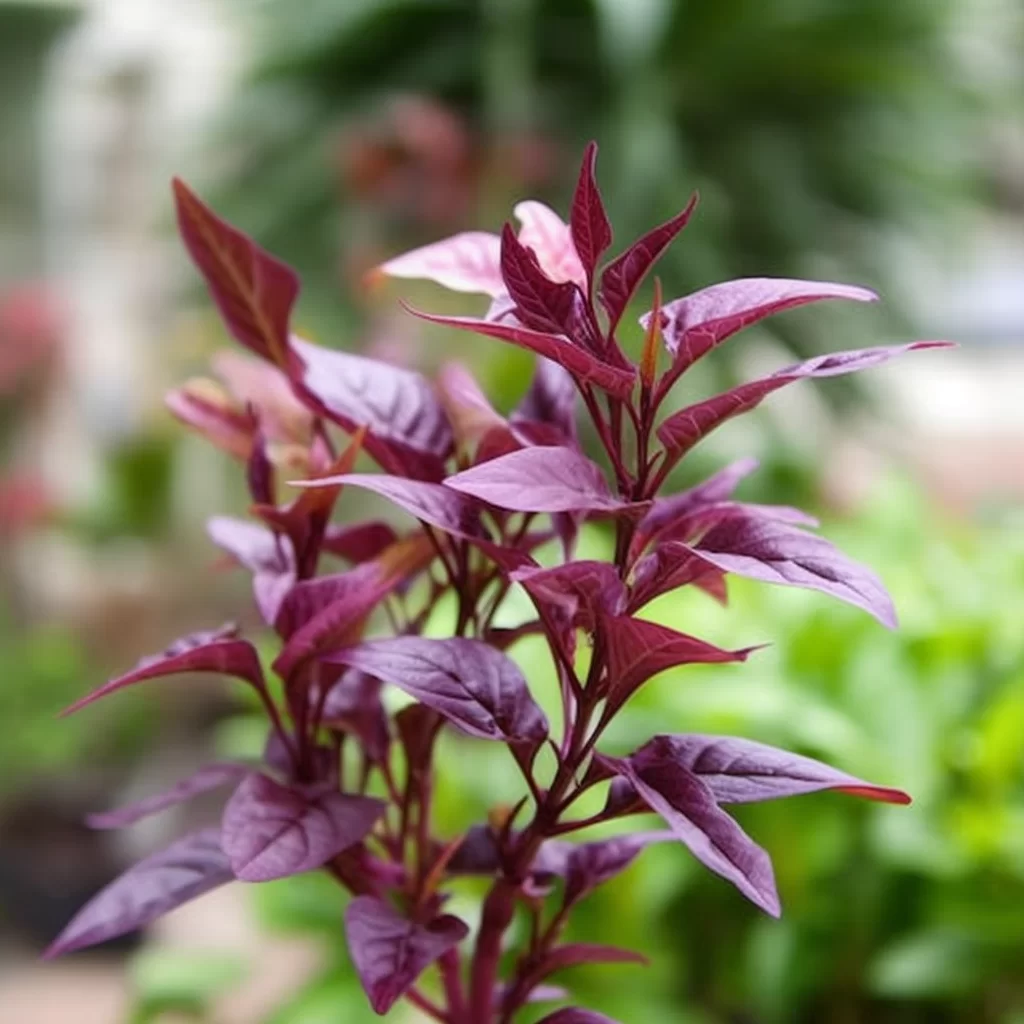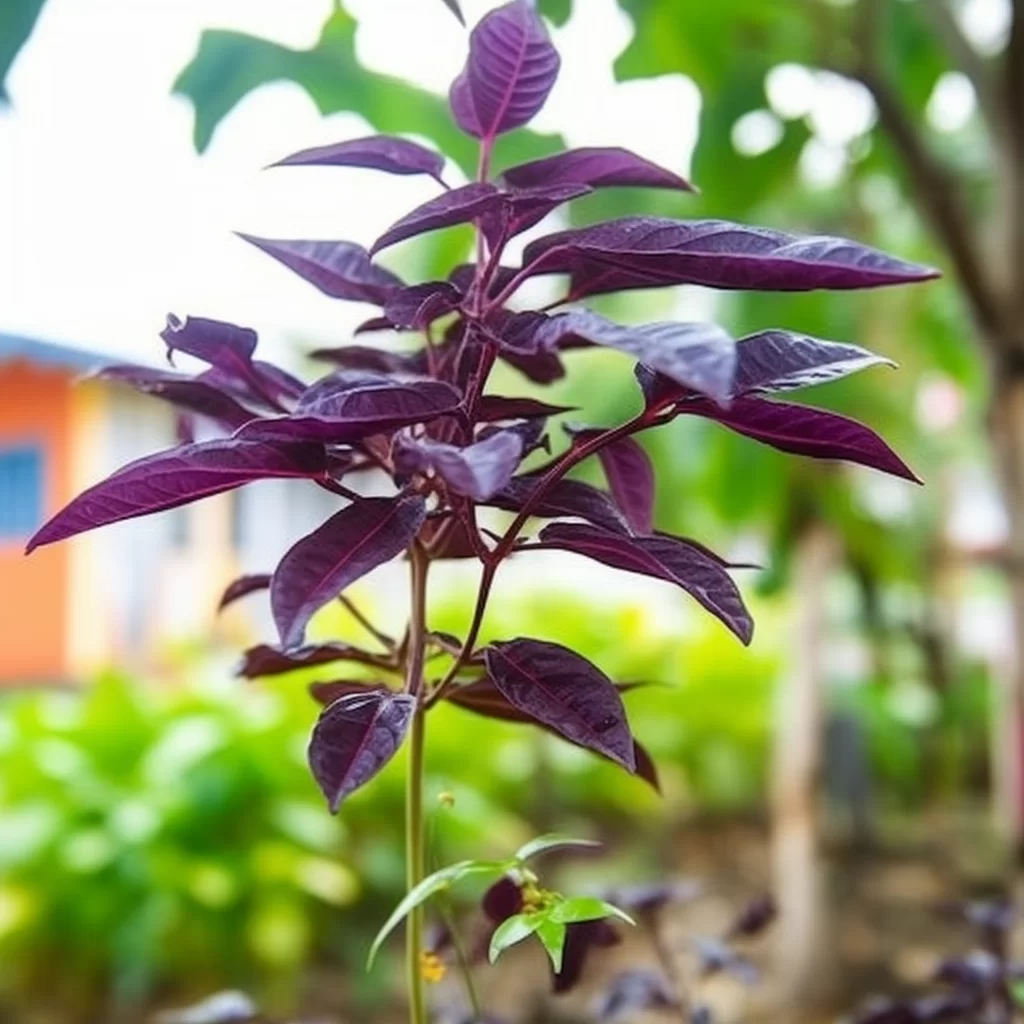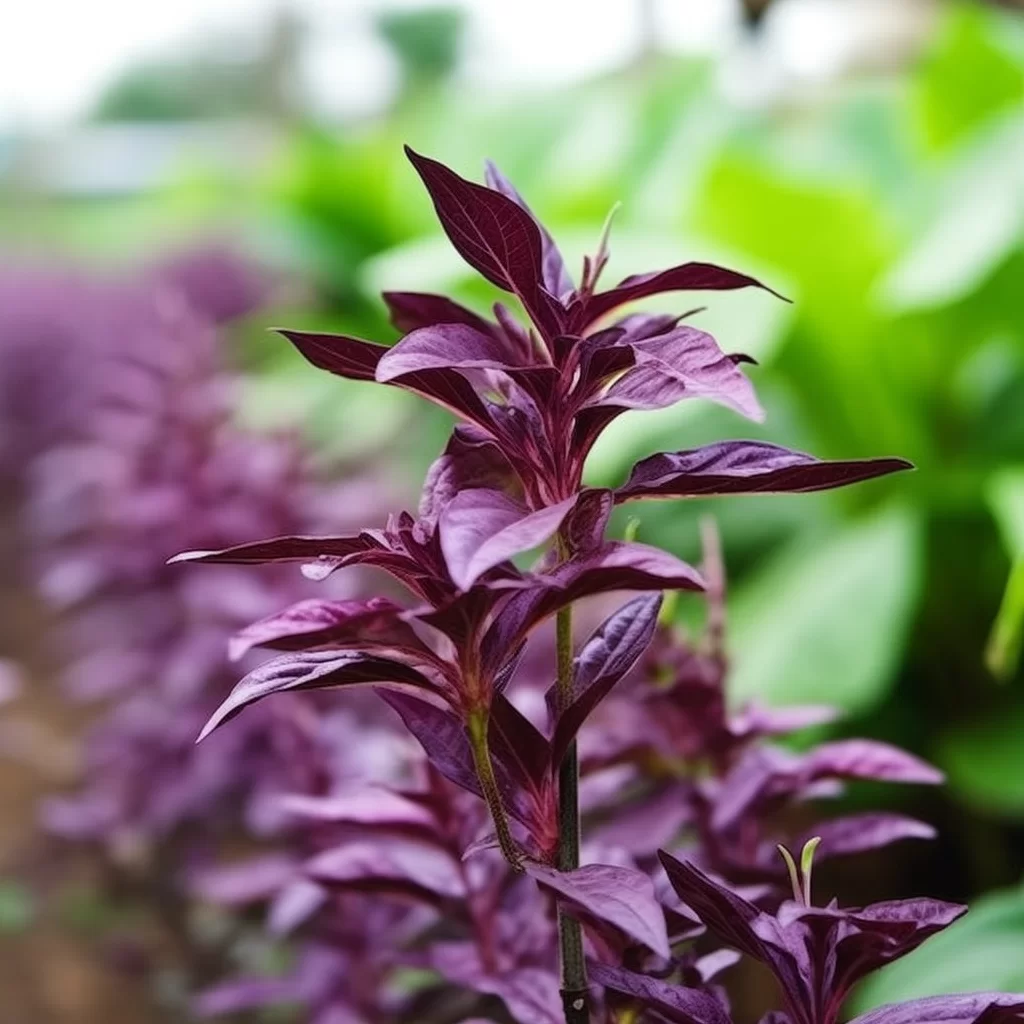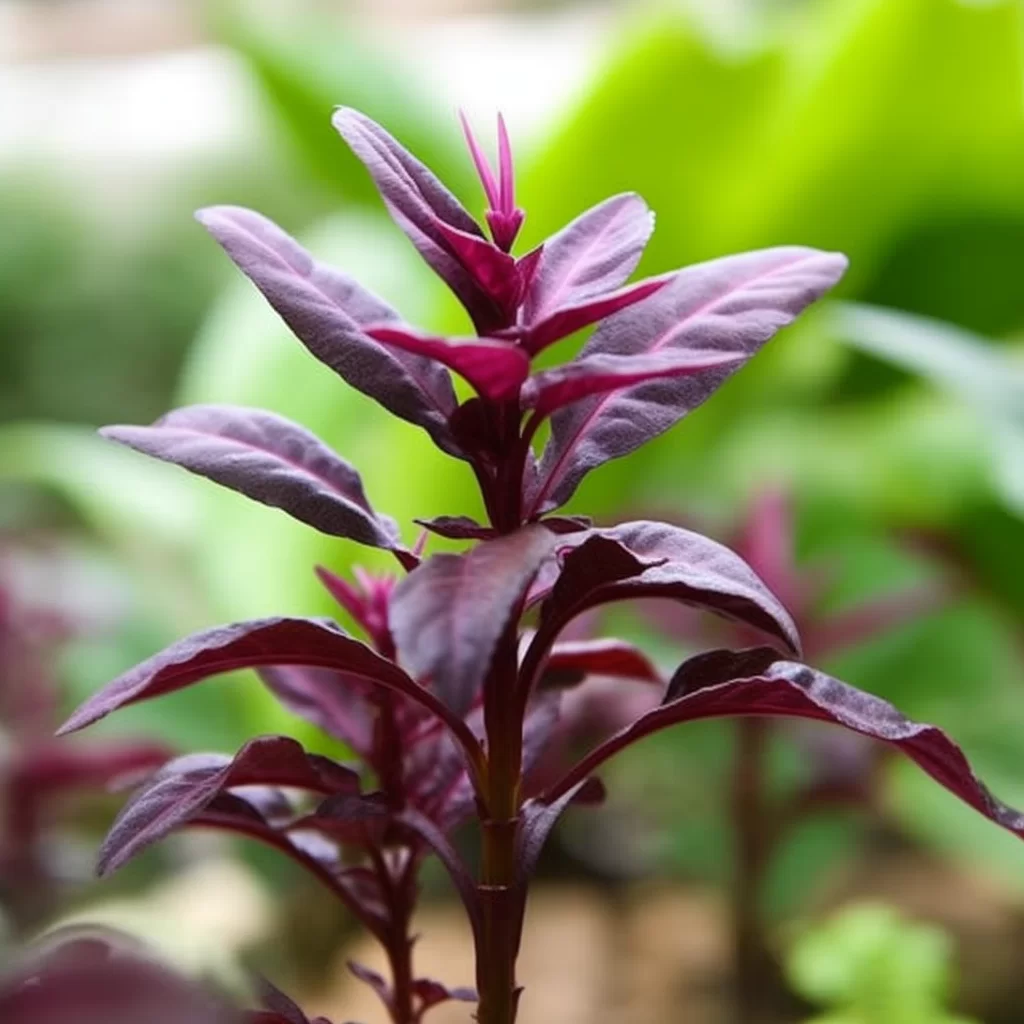Story of Day :
Contents
- 1 The Purple Basil Plant: A Complete Guide and Care Tips
- 2 What is Purple Basil?
- 3 How to Plant Purple Basil
- 3.1 Outdoor Planting Selecting Your Location: Choose a sunny location where your plants will receive ample sunlight throughout the day. Sowing Seeds:You can sow purple basil directly into garden beds or raised garden beds. Sow seeds about 6-8 inches apart and thin them to one plant per spot once they have grown. Caring For Seedlings: Purple basil needs at least 1 inch of water per week, so make sure to keep the soil moist but not waterlogged. Fertilizing Seedlings: Use organic fertilizer or compost during planting and later in the growing season when plants start flowering for optimal growth. If you’re looking for a unique and flavorful addition to your herb garden, purple basil is an excellent choice. Not only does it add a pop of vibrant color to your space, but it also offers a slightly sweeter taste than traditional green basil. To keep your purple basil thriving, there are some essential care tips to keep in mind. Firstly, make sure it receives enough sunlight – at least six hours per day – and water thoroughly when the soil starts to dry out. You can also fertilize every two weeks with a balanced fertilizer.It’s worth noting that purple basil is more susceptible to pests and disease than other herbs, so be mindful of any signs of infestation or wilting leaves. Regular pruning will help keep the plant bushy and healthy while providing you with fresh leaves for culinary use. Lastly, if temperatures drop below 50 degrees Fahrenheit at night, consider bringing the plant indoors or covering it with frost cloth to protect it from cold damage during the fall and winter months. With proper care and attention, you can enjoy deliciously fragrant purple basil year-round in your garden or kitchen windowsill! Purple basil plants are a beautiful addition to any garden, but it’s important to take proper care of them if you want them to thrive. First and foremost, make sure your plant is getting enough sunlight. Basil loves warm weather and needs at least six hours of direct sunlight per day. If you’re growing your plant indoors, place it near a sunny window or use artificial grow lights to mimic natural light.In addition to sunlight, be sure to water your purple basil regularly. The soil should be kept moist but not too wet or waterlogged. You can also fertilize your plant every few weeks with a balanced fertilizer, which will help keep the leaves healthy and promote growth. By following these simple care tips, you can ensure that your purple basil plants will stay strong and vibrant all season long! Watering Guidelines
- 3.2 Fertilization Guidelines
The Purple Basil Plant: A Complete Guide and Care Tips
Are you tired of the same old green herbs in your garden? Switch things up with a purple basil plant! This versatile plant is not only visually stunning with its bright purple leaves, but it also adds an unexpected twist to any dish with its unique anise flavor.
As a member of the mint family, it is easy to grow and maintain, even for beginners.
With our comprehensive guide, you will have all the information you need to successfully cultivate and care for your own purple basil plants.From seed-starting tips to pruning techniques, we’ve got you covered.
Not only will this beautiful herb add some excitement and variety to your garden, but it may just become one of your go-to ingredients in the kitchen as well.
So why settle for plain old green herbs when you can have something more vibrant and flavorful? Give purple basil a try – we promise you won’t be disappointed!
What is Purple Basil?
Purple basil, scientifically known as Ocimum basilicum ‘Purpurascens’, is a unique and attractive variation of the sweet basil herb.
This type of basil is distinguished by its vibrant dark purple leaves that can add a pop of color to any garden or kitchen windowsill.
It’s an easy-to-grow plant that can reach heights between 12-24 inches and widths up to 10-18 inches, making it ideal for small spaces like balconies or container gardens.
Purple basil’s fragrant leaves are commonly used in cooking to infuse dishes with a sweet and slightly spicy flavor. In addition to its culinary uses, purple basil also boasts medicinal properties.
In addition to its culinary uses, purple basil also boasts medicinal properties.
The essential oils found in this herb have antioxidant and anti-inflammatory effects that may help reduce stress levels and promote better heart health.
Growing purple basil is relatively simple as long as it receives adequate sunlight, well-draining soil, and regular watering.
This versatile plant can also be grown indoors under grow lights during winter months when outdoor growing isn’t feasible.
Types of Purple Basil
- Ocimum Basilicum ‘Dark Opal’: This variety has dark purplish-red leaves that are almost black in color.
It has a stronger taste than other varieties.
- Ocimum Sanctum ‘Purple Ruffles’: This variety produces large frilly leaves with deep burgundy-purple coloring.
It has a slightly spicy taste.
- Ocimum x citriodorum ‘Pesto Perpetuo’: This variety produces green and white variegated leaves with touches of purple throughout.
It’s great for use in pesto recipes since it has a strong lemony scent when crushed.
Purple basil is a popular herb that belongs to the mint family.
It has a unique and distinct flavor that is often used in various culinary dishes, such as salads, soups, and pasta sauces.
When exploring how to grow purple basil, it’s important to consider the growing conditions needed for it to thrive.
 Firstly, purple basil requires well-draining soil with adequate moisture levels.
Firstly, purple basil requires well-draining soil with adequate moisture levels.
It’s best to plant it in full sun or partial shade with temperatures ranging from 65-80°F (18-27°C).
Purple basil is an annual herb that can grow up to 2 feet tall if provided with the right care and attention.
Regular pruning of the leaves will encourage bushier growth and promote better air circulation around the plant.In summary, if you’re looking to grow purple basil successfully at home or in your garden, you’ll need to provide it with well-draining soil containing adequate moisture levels while planting in full sun or partial shade with regular pruning of its leaves.
With these simple steps taken into consideration along with some care and attention – your purple basil will thrive beautifully!
Growing purple basil plants can be a fun and rewarding experience.
However, it is important to note that these plants do have specific growing requirements that need to be met in order for them to thrive.
For instance, they require well-draining soil with a pH level between 6.0 and 7.5, as well as plenty of sunlight and consistent watering.
Proper pruning techniques are also essential for optimal growth.Despite their distinct needs, purple basil plants are relatively easy to grow once you have the right knowledge and tools at hand.
Many gardeners enjoy incorporating them into their herb gardens or using them as an ornamental addition to flower beds due to their vibrant coloration and pleasant aroma.
With some patience and attention to detail, anyone can successfully cultivate healthy purple basil plants that will add flavor and beauty to any outdoor space or culinary dish!

Light Requirements
Purple basil needs full sun to grow and develop its distinctive color and flavor.
It requires a minimum of 6 hours of direct sunlight each day.
Soil Requirements
Purple basil is a popular herb that is easy to grow.
To ensure your purple basil thrives, it’s important to plant it in moist, well-drained soil.
The ideal pH level for the soil should be between 6.0 and 7.5.
If the pH level is too low or acidic, this can adversely affect the growth of your plants and they may not reach their full potential.To avoid any issues with your purple basil, it’s important to keep an eye on the pH levels of your soil.
You can test this using a pH testing kit that you can purchase from garden centers or online stores.
By ensuring that you have the right balance of acidity and moisture in your soil, you’re giving your plants a strong foundation to grow from and will ultimately lead to higher yields of delicious leaves for use in cooking or as decoration!

Temperature Requirements
Purple basil, an herbaceous plant with vibrant purple leaves and a unique aroma, is known for its love of warmth.
This annual plant thrives in temperatures ranging between 70-85°F (21-29°C), making it the perfect addition to your summer garden.
While some basil varieties can handle cooler weather conditions, purple basil is not one of them and should be kept away from frost or freezing temperatures at all times.
If you live in a colder area, consider growing this herb indoors or wait until the warmer months to add it to your garden.If you’re thinking about growing purple basil this season, remember that it needs plenty of sunlight and well-draining soil to flourish.
The warm weather-loving plant will produce more leaves if exposed to at least six hours of direct sunlight each day.
Also, be mindful that too much moisture can cause root rot and affect the plant’s overall health.
Ensure that the soil drains efficiently by adding perlite or sand when planting purple basil seeds or transplants into your pot or garden bed.
With proper care in ideal temperature conditions between 70-85°F (21-29°C), you’ll soon have an abundant supply of flavorful and aromatic fresh herbs at hand!
How to Plant Purple Basil
Purple basil is a herb that can be grown successfully both indoors and outdoors, depending on the climate in your area.
Essentially, if you live in a region where the temperature is consistently warm and sunny, you can plant purple basil outside in the ground or in pots.
However, if you reside somewhere with cold winters or harsh weather conditions that are not conducive to growing plants outdoors, it’s best to grow your purple basil indoors.
When planting indoors, make sure to keep your plant near a window where it can get plenty of natural sunlight and ensure that the soil remains moist at all times.Whether you choose to grow your purple basil inside or out will depend on factors like temperature fluctuations and weather patterns unique to your location.
Regardless of where you decide to plant this versatile herb though, it’s important to pay attention to its needs so that it grows strong and healthy.
With proper care and attention given toward sunlight exposure as well as watering habits (and even pruning), anyone can enjoy their very own thriving patch of fresh purple basil right at home!
Indoor planting is a great way to bring the beauty of nature into your home while also enjoying fresh herbs and vegetables all year round.
Purple basil seeds or cuttings can be easily grown indoors in small pots with proper care and attention.
Choosing the right container is important, ensuring that it has drainage holes at the bottom to avoid waterlogging of roots.
When sowing seeds, add potting mix to your container, leaving some space for watering later on.
Gently press two seeds into the soil without covering them with extra soil.
To care for seedlings, make sure they receive bright light but are protected from direct sunlight until they are more established.
Liquid fertilizer can be added every two weeks after seed germination has occurred for optimal growth.Growing indoor plants not only adds aesthetic value to your living space but also contributes towards improving air quality and reducing stress levels.
Growing purple basil indoors is a simple process that requires minimal effort but yields maximum rewards in terms of flavor and health benefits.
The first step in this process involves selecting an appropriate container with drainage holes at the bottom for adequate water flow to prevent root rot or disease buildup.
Once you’ve chosen your pot, sow two purple basil seeds per pot by gently pressing them into moistened soil without burying them deep within it.
For best growth results, keep the seedlings under bright light while protecting them from direct sunlight until they’re sturdy enough to withstand it themselves; feed using liquid fertilizer once every 2 weeks after germination occurs as well!
Outdoor Planting
- Selecting Your Location: Choose a sunny location where your plants will receive ample sunlight throughout the day.
- Sowing Seeds:You can sow purple basil directly into garden beds or raised garden beds.
Sow seeds about 6-8 inches apart and thin them to one plant per spot once they have grown.
- Caring For Seedlings: Purple basil needs at least 1 inch of water per week, so make sure to keep the soil moist but not waterlogged.
- Fertilizing Seedlings: Use organic fertilizer or compost during planting and later in the growing season when plants start flowering for optimal growth.
If you’re looking for a unique and flavorful addition to your herb garden, purple basil is an excellent choice.
Not only does it add a pop of vibrant color to your space, but it also offers a slightly sweeter taste than traditional green basil.
To keep your purple basil thriving, there are some essential care tips to keep in mind.
Firstly, make sure it receives enough sunlight – at least six hours per day – and water thoroughly when the soil starts to dry out.
You can also fertilize every two weeks with a balanced fertilizer.It’s worth noting that purple basil is more susceptible to pests and disease than other herbs, so be mindful of any signs of infestation or wilting leaves.
Regular pruning will help keep the plant bushy and healthy while providing you with fresh leaves for culinary use.
Lastly, if temperatures drop below 50 degrees Fahrenheit at night, consider bringing the plant indoors or covering it with frost cloth to protect it from cold damage during the fall and winter months.
With proper care and attention, you can enjoy deliciously fragrant purple basil year-round in your garden or kitchen windowsill!
Purple basil plants are a beautiful addition to any garden, but it’s important to take proper care of them if you want them to thrive.
First and foremost, make sure your plant is getting enough sunlight.
Basil loves warm weather and needs at least six hours of direct sunlight per day.
If you’re growing your plant indoors, place it near a sunny window or use artificial grow lights to mimic natural light.In addition to sunlight, be sure to water your purple basil regularly.
The soil should be kept moist but not too wet or waterlogged.
You can also fertilize your plant every few weeks with a balanced fertilizer, which will help keep the leaves healthy and promote growth.
By following these simple care tips, you can ensure that your purple basil plants will stay strong and vibrant all season long!
Watering Guidelines
Purple basil is a delightful and versatile herb that requires regular watering to thrive.
However, it is essential to avoid overwatering as the plant cannot tolerate standing water.
To ensure healthy growth, it’s crucial to keep the soil consistently moist by watering deeply once a week or whenever the top inch of soil feels dry to the touch.
Consistency in moisture is key for this herb as too much or too little water can lead to stunted growth or even death of the plant.It’s also worth noting that purple basil needs proper drainage in its potting container or garden bed.
Waterlogging can cause root rot, which may ruin your beloved plants’ health entirely.
So make sure you’re using well-draining soil and containers with drainage holes for optimal results.
By providing adequate moisture levels and ensuring proper drainage, you’ll be rewarded with beautiful and fragrant purple basil leaves that are perfect for adding flavor and color to all sorts of dishes!
Fertilization Guidelines
Basil, a common herb in many kitchens, requires a lot of nutrients to grow healthy and strong.
For this reason, it is important to provide regular fertilization throughout its growing season.
To ensure optimal growth for young seedlings, an all-purpose fertilizer should be used every two weeks.
For more mature plants, weekly fertilization is recommended.Fertilizing basil regularly helps to promote larger and more flavorful leaves that are perfect for cooking.
It also ensures that the plant remains healthy and vibrant all season long.
By following these simple steps of consistent fertilization with an all-purpose fertilizer at the appropriate intervals depending on the age of the plant, you can cultivate a thriving basil garden in your own home or backyard!
Preventing pests from invading our homes and gardens is crucial to maintaining a healthy living environment.
There are several measures that we can take to prevent pests from infesting our spaces.
First and foremost, it is essential to keep all areas clean and tidy, as pests are attracted to food sources and clutter.
Regularly emptying trash cans, cleaning dishes promptly after use, and sweeping floors will help eliminate potential food sources for pests.
Additionally, sealing off entry points such as cracks in walls or windows will help prevent pests from entering the space.Another important measure in pest prevention is promoting a healthy ecosystem in outdoor spaces.
This can be done by planting pest-resistant plants or herbs that repel insects naturally.
Using organic fertilizers instead of chemical ones can also help create a healthy environment for beneficial insects that prey on harmful ones.
Additionally, regularly pruning trees and bushes will reduce potential hiding spots for rodents or other pests.Overall, taking preventative measures against pest infestations not only maintains the cleanliness of our spaces but also promotes a healthier living environment for ourselves and those around us.
Purple basil plants are often susceptible to pest infestations, with common culprits like aphids, spider mites, and whiteflies causing damage to the leaves.
These unwelcome visitors can quickly destroy entire crops if left unchecked.
Thankfully, there are a few natural solutions that gardeners can utilize in order to keep these pests at bay.
One option is neem oil soap solutions which act as an effective insect repellent.
.If you are growing purple basil in your garden, it’s important to be aware of the potential for insect damage and take steps to prevent it from happening.
Fortunately, there are several ways you can do this without resorting to harmful chemicals or pesticides.
The use of neem oil soap solutions and companion planting with marigolds or garlic provide simple yet effective strategies for keeping pests away from your plants naturally.
By incorporating these methods into your gardening routine, you’ll be able to enjoy flavorful and healthy purple basil yields all season long!
If you love cooking, then purple basil leaves are a must-have ingredient in your garden.
This herb is perfect for adding flavor and color to dishes such as salads, pasta dishes, and even cocktails.
Harvesting purple basil leaves is easy once you know what to do.
Start by identifying mature plants that have grown at least six inches tall.
Then, pick the leaves one by one or remove entire stems using scissors or gardening shears.It’s important to note that you should avoid harvesting more than a third of the plant at once as this can damage and stress it.
Additionally, make sure to wash the harvested leaves thoroughly before use to remove any dirt or insects that may be on them.
Purple basil is an excellent herb for beginner gardeners because it’s easy to care for and produces a lot of flavorful leaves throughout the growing season with regular harvesting.
So why not add some purple flair to your next dish with fresh-picked basil?
If you’re an avid gardener, then you know how important it is to maintain the growth and production of your plants.
Harvesting too much from any single plant can have adverse effects on the overall yield.
This is because plants rely on leaves for photosynthesis, which is necessary for their survival and growth.
Thus, when harvesting leaves from your plants, it’s essential to take only a few leaves from various parts of each plant so they can still carry out their process of photosynthesis efficiently.Additionally, over-harvesting can also lead to a decrease in quality and taste of your crops.
When you harvest too many vegetables or fruits at once from a single plant, its resources become depleted quickly.
This results in smaller or fewer yields later on in the season as well as potentially compromising the taste and quality of what remains.
Therefore, taking only what’s needed ensures that you’ll have enough produce while still having healthy thriving plants that will continue providing fresh fruit and veggies throughout the season/year!Purple basil is a wonderful addition to any herb garden and can be harvested around 30-40 days after transplanting the seedlings.
If you’re interested in harvesting this delicious herb, it’s best to do so in the morning when the leaves are at their freshest and most flavorful.
You’ll want to pluck off the leaves carefully, taking care not to damage any of the surrounding foliage.Once you’ve harvested your purple basil leaves, there are plenty of ways to use them in your cooking.
You can add them fresh or dried to pasta dishes, soups, stews or salads for an extra kick of flavor.
The beautiful purple color also makes it a great garnish for cocktails or fruit salads.
So why not try growing some purple basil today and see what creative culinary uses you can come up with?
In conclusion, it is important to reflect on the main points and takeaways from the discussion.
Final thoughts are crucial as they summarize the key ideas and insights that have been shared throughout the discourse.
It is also an opportunity to express any remaining questions or concerns that may have arisen during the conversation.Moreover, final thoughts can serve as a call-to-action for further exploration and action.
They can inspire individuals to continue learning about a given topic or to consider ways in which they can apply what they have learned in their personal or professional lives.
Ultimately, final thoughts help bring closure to a discussion while highlighting its significance and encouraging ongoing engagement with its themes.
Purple basil is a great choice for herb gardeners who want to add some flair to their home cooking.
This unique variety boasts a rich, deep purple color and an unmistakable flavor that will make any dish stand out.
By taking the time to properly care for your plants through regular watering, fertilizing, and pest prevention measures, you can ensure a bountiful harvest of this tasty herb in no time.To grow healthy purple basil plants, it’s important to provide the right growing conditions.
These herbs prefer well-draining soil and plenty of sunlight.
Regular watering is essential to keep them hydrated in hot weather or during dry spells.
Fertilizing with a balanced blend of nutrients every few weeks can help encourage robust growth and maximize yields come harvest time.
Additionally, taking preventative measures against pests like aphids or spider mites can help keep your plants healthy throughout the growing season.
With these tips in mind, adding some pizzazz to your cooking with purple basil has never been easier!
Sow seeds about 6-8 inches apart and thin them to one plant per spot once they have grown.